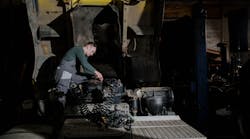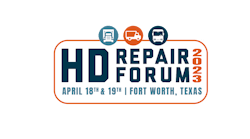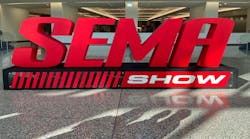During the American Trucking Association’s (ATA) Technology & Maintenance Council (TMC) 2021 Spring Meeting, a virtual discussion session was held with the S.17 Collision & Corrosion Control study group. The “Shop Talk” for collision and corrosion control highlighted many aspects of the collision-to-repair verification process, including challenges faced, best practices for successful navigation of this process, and insight into what TMC is doing to help fleets and body shops alike as this segment of the industry is further investigated.
The online discussion panel featured host and moderator Chris Sterwerf, COO of Fairfield Auto & Truck and vice chair for S.17; Jim Kolea, president of PennFleet Corporation; John Spoto, national heavy duty truck commercial fleet manager, 3M; and Peter Smith, fleet operations manager of HP Hood.
“Collisions are a hugely traumatic event … for a fleet company to repair,” Kolea said when asked why the topic of collision repair was of growing interest and concern to the industry. “Bad repairs can add insult to injury by contributing to a secondary incident if the vehicle is not repaired correctly the first time.”
Sterwerf concurred, and further emphasized that the severity of collisions is not missed on anyone – not only from safety and accountability standpoints, but also from an asset management perspective.
“As advanced as they are getting now, fleets want to make sure that their asset is not getting devalued,” he said. “We want to make sure that their truck and their collision mitigation systems are functioning properly [after a collision repair]. And again – collision mitigation systems: They are collision mitigation systems, not collision elimination systems.”
This point was reinforced by a poll taken of session attendees, in which 79 percent of participants indicated that their fleet had experienced between one and three wrecks or rollover events in the past year (an additional seven percent indicated between four and 10, and an additional seven percent indicated 10 or more). It was made clear that fleets today are frequently dealing with collisions and the collision repair process.
Conjunctive damage and collision implications
Kolea explained conjunctive damage occurs when a vehicle is impacted and that impact “goes throughout the vehicle.”
“It is interesting to not just be looking at the area where the impact was, but following that through, looking at the ADAS sensors, the steering sensors … There are so many ways that those G forces can completely change a vehicle from a way it is intended to be used,” he said. “Aftertreatment system connections, the ceramic filters and plates … Everyone knows the aftertreatment system issues as they are today … but this is another thing that can stir up aftertreatment issues – an accident.”
Sterwerf also followed up on the impact collisions may cause to aftertreatment systems. Noting that these systems operate under extreme temperatures, he stated that the metals essentially become heat-treated and may become brittle over time. Furthermore, the ceramic and the filter itself are prone to conjunctive damage.
“When you add the G force of an impact to a truck, there is a good chance that ceramic could crack, or one of the pipes or connections of that aftertreatment system could shift and cause a leak,” Sterwerf said.
Checking beyond the point of impact is essential when collision repair services are carried out. As it applies specifically to the aftertreatment system, Sterwerf mentioned there is pressure testing equipment, smoke testing equipment, and diagnostic testing equipment available to determine if the system has been affected by the collision.
“Body shops should be looking for this, because if we hand the vehicle back to the driver and they head down the road, the system could go into derate,” he posed. “Next thing you know, you have a truck down on the side of the road … It is another opportunity for the shops to help out the fleets to make sure these systems are taken care of, because if someone else hit that truck and that accident wasn’t the trucking company’s fault, or the driver’s fault, why should the fleet pay for that aftertreatment system repair down the road when it was really attributable to somebody else that caused the accident?”
Beyond secondary damage, other implications to consider when dealing with collision repair are the influences on vehicle technology performance.
“I call it the dash light myth,” Sterwerf said. “Just because there isn’t a dash light doesn’t mean there isn’t a problem, especially after a major repair like a collision, or major steering components, or frame geometry changes. The computers only know what is given to them.”
Sterwerf explained the end-of-line calibration OEs exercise to allow vehicle sensors to understand where they are in space, where they are on the vehicle, and the near-perfect environment these calibrations are conducted in.
“There are things we, as repairers, can do that can completely screw that up,” he warned.
“The electronic stability control sensor – that is mounted to a cross member of the frame, typically,” Sterwerf continued. “If we add an axle, or delete an axle, or correct the frame, or change a cross member, and that sensor gets relocated – possibly because of a part change, and say that part has different mounting holes … If you change the location of that sensor even one-quarter of an inch, you can cause that truck to brake erratically. Or, if it is too high or too low, it can cause a truck to enhance a rollover, or brake when it is not intended to because it thinks it is in a rollover when it is not … There are times when a repairer can change things on a truck and it’s not going to throw a code.”
Understanding such nuances to collision repair and its effects on vehicle technologies does not just stop with the electronic stability control sensor. Take, for instance, forward facing cameras behind the windshield. Sterwerf relayed that in a previous TMC meeting he demonstrated that glass installers were utilizing “any old double-sided tape” to place the camera wherever they saw fit back onto the windshield. Factors such as the thickness of the tape and the camera’s physical location placement on the windshield would degrade what the camera was doing – causing issues with focusing. He continued, saying that in this particular instance the camera had to be mounted with a specific bracket and tape of a specific color and thickness. After doing so, the camera was able to function properly.
“Is the glass installer supposed to be handling that?” Sterwerf asked. “Is the body shop supposed to be handling that? Somebody has got to do it – or else the driver ends up in a bad situation and his backstop for safety is removed.”
Kolea also added that cracks in the windshield that run over the camera’s lens will also cause issues with the camera’s performance and will require windshield replacement.
Furthermore, Kolea spoke to repairers and fleets not having the proper training nor equipment for ADAS calibrations. The attendees of the session were polled on their confidence in their repairer-of-choice’s training and capacity for ADAS. A majority of attendees (64 percent) were unsure and intended to look into this further, with only 14 percent of attendees responding that yes, they feel confident. This poll seemed to represent more than just the questioned posed, but also indicated that there may be disconnect in repair verification.
Attendees were polled again; this time having been asked who is responsible for verifying ADAS repair when such outsourced repairs have been completed. An overwhelming majority (89 percent) of attendees placed this responsibility upon the fleet maintenance manager.
“In the end, it is your truck and your drivers that you are putting on the road,” Sterwerf attested upon viewing the results of the poll. “You need to trust and verify what your repair is doing.”
He also suggested to maintain a habit of running diagnostic scans post collision repair. He recognized that issues may not arise before performing dynamic test drives or completing several key cycles.
Communication across all parties
The attendees and panelists of the session were a mixed composition of those completing collision repairs in-house or outsourcing collision repairs. Whatever the case may be, communication was iterated as a key component to success, safety, and efficiency.
From the perspective of a fleet that outsources their maintenance and collision repair, Peter Smith stated that maintaining a good relationship with their third-party provider has been critical.
Smith said that he remains directly involved in each case where equipment is out for collision repair; and having the close relationship with the provider has allowed him to remain informed and assists with decision making. Along with that, repair inspection has been eased as his ability to be directly involved grants the capacity to relate any concerns or questions to the service provider.
“It’s really in the partnership,” Smith said. “If we have a good partnership with the maintenance provider and they have a good partnership with the service provider, I find that it is very beneficial. If we don’t, then we leave ourselves wide open for failures after the fact.
“Communication is very critical,” he continued. “Not only at the beginning, but during and after the fact with follow up as well … To me, it doesn’t end when we get [an asset] back, it ends about 90 days downstream, to make sure nothing else appeared.”
“Communication is huge,” Kolea agreed. “If a customer calls us to check on the status of their vehicle, I feel as though we are not doing our job, because our job truly is to communicate. Our job is to do the repairs to the vehicles and make sure that we have a great communication expressway between both the customer and our shop.”
A question was raised during the session regarding maintaining the integrity of data when amidst this communication process, particularly when multiple parties are involved. Sterwerf stated that this subject alone should become a Recommended Practice (RP) itself as many in the collision repair space deal with this.
The suggestion of creating a standard NDA was brought forward to assist in maintaining confidential data or information.
Robert Braswell, executive director of ATA’s TMC, reminded attendees that TMC does have an RP on Guidelines on Event Data Collection Storage and Retrieval (RP-1214A). Though it does not specifically discuss the removal of the vehicle’s ECU for example, nor an NDA, it does address data extraction and data ownership. He also agreed that further development on this RP to answer those questions raised is important.
Collision repair hot topics
Throughout the session, many pressing subjects in collision repair were raised. The role of fasteners and their importance was amongst them.
Spoto noted that a familiar technician sentiment seems to be “‘Put the attachment in that fits and that is the one we are going to use’ … [It] doesn’t work that way.
“Rivets of today are critical in repairability,” he continued. “And, how important it is to have the guns recalibrated, making sure they are properly checked out once in a while.”
Sterwerf concurred, agreeing that the wrong rivets in the wrong place can cause a windfall of problems, including safety concerns and corrosion.
The topic of panel replacements was also raised during the discussion as there are varying ways in which repairers are executing such service, specifically with aluminum side panels. Where the side panel meets the sleeper cap, some are making the choice to cut the formed right angle to avoid taking the sleeper roof off.
“The technician takes it upon themselves, thinking ‘If I cut it, it’s not going to hurt because I am going to stuff it back up there and put a ton of adhesive, and I am going to rivet.’ But at the same time, being that you’ve cut it, you’ve weakened it,” Spoto said of the repair job scenario.
Both Spoto and Sterwerf used a cardboard box as an analogy to drive the point home, with Sterwerf performing a physical demonstration on camera of cutting a corner of the box to display the loss of structural integrity.
Along with panel replacement, the session panelists attested to the rise in popularity of glue pulling and its rightful viability in many cases where a replacement may not be necessary.
Another “hot” topic – arc welding. RP-165, Proper Arc Welding Procedures, was mentioned as a resource to pay attention to. Sterwerf warned of how easy it is for an arc to jump from circuit to circuit, especially with today’s small computer chips and circuit boards, and emphasized utilizing that RP as a guideline.
Yet another consideration repair shops must keep in mind is the continued development of alternatively powered vehicles and vehicle electrification. Compressed natural gas (CNG), liquid natural gas (LNG), and hydrogen pose some challenges.
“A body shop is considered a hot shop,” Kolea said. “We grind and we weld. In the world of CNG and LNG, we need to make sure that vehicles are defueled before they come into the shop.”
Explosive hazards and fire hazards require tedious and incredible adherence to safety protocols as alternative fueling systems become more prevalent in today’s commercial vehicle market. Kolea also mentioned that fuel system inspections are of paramount importance, since any leaks would raise the potential for a fire or explosion in the shop.
With electric trucks, specific personal protective equipment (PPE) is required when handling the high voltage systems. Batteries on these systems are also sensitive to heat. Sterwerf reminded that the heat and static electricity within paint booths may cause issues and advised to the proper and safe removal and storage of the battery before the vehicle is in a heated booth. Spoto agreed and stated that this is the hottest topic within the ICAR community currently.
For the fleets
For fleets that are outsourcing collision repair, Smith provided some suggestions and best practices that have been successful.
Get a copy of all estimates, he said, and be sure to monitor and account for the proposed labor time estimates. Smith also suggests forwarding along the latest PM reports on that vehicle so that repairers understand some history of the vehicle’s performance and any recent repairs made. Smith also warned that parts orders today are slow, and that some manufacturers are not even committing to fulfilment dates – so preparation where possible is advisable.
For the repairers
Useful tips and tricks were presented for those carrying out collision repairs.
Get as much information upfront as possible. Was the truck loaded during the accident? Were there pre-existing dash lights, ADAS issues, or ride issues? If the vehicle was rolled over, how long was the vehicle rolled over with the engine running? This helps to know where to look for secondary damage and to make sure nothing is missed.
Getting the vehicle back to the fleet in a timely fashion is important, but set fair expectations and relay that information to the fleet on what sort of things may cause delays throughout the process.
Sterwerf concluded the meeting by reminding attendees that there is a lot of support available in the industry, particularly training.
“Seek it out, be thirsty for this information, and you will be ahead of the pack,” he said.



